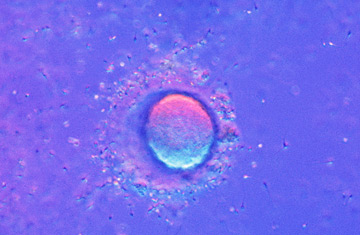
A human egg surrounded by sperm. Magnification 400X.
There are two basic twin types now, identical and fraternal, but a third type is the focus of a new discovery. The story of these one-of-a-kind twins begins after natural conception and an uncomplicated term pregnancy, when the newborns were brought to the attention of science because one is anatomically male and one has sexually ambiguous genitalia.
For the first time, researchers have identified twins that are identical on their mother's side, but share only half of their father's DNA. The twins, now toddlers, have been described as "semi-identical" — caught somewhere between identical twins (the result of the cleaving of an egg fertilized by one sperm) and fraternal twins (the result of two eggs meeting two sperm). Lead investigator Dr. Vivienne Souter says that while the term semi-identical provides some idea of how the twinning occurred, it is "an oversimplification."
According to a study published in the Mar. 28 issue of Human Genetics, two sperm fertilized one egg and created the twins. The phenomenon occurs in about 1% of the population, but most embryos created in this way — called triploids because they have three sets of chromosomes — do not live. Says Dr. Mary Jane Minkin, a clinical professor of obstetrics and gynecology at Yale University: "This confirms that two sperm can get into an egg." Normally the cell dies. But Minkin makes a valid point: "Never say never in medicine and biology."
In the study, Souter and her colleagues suggest that there are two ways this could have happened, depending on when the actual twinning event took place. In the first scenario, the egg might have divided in two (without separating) and then each part fertilized by one sperm. Egg division before fertilization is very rare, says Minkin. The second, more likely possibility is that the egg fused with two sperm cells and created a triploid cell. Then, at the second-cell stage, each shed the chromosomes from each of the sperm — or did something to correct its chromosomal count, says Souter. "There are a whole host of potential mechanisms to explain this," she says, "but we really just don't know. We do know there were two genetic contributions from dad and one from mom."
"We think that the egg probably carried an X and one sperm an X, and one sperm a Y. It's possible that it is far more complicated than that. But that's the simplified explanation," says Souter. The twins have different proportions of male cells (XY) and female cells (XX), and are chimeric, meaning they have tissue with a diverse genetic make-up. Twin A, identified as a hermaphrodite, has 5% XY and 95% XX after genetic testing of the skin. Comparatively, Twin B, the male, has 50% XX and 50% XY.
Dr. Eric Vilain, professor of urology and human genetics at the David Geffen School of Medicine at UCLA says: "You don't need to have 100% Y-chromosome to be male. If you have more than 15% of Y-chromosome in the gonads it's likely that you're going to be a male." Twin A, he adds, is ambiguous because the number of cells carrying a male-determining chromosome was not high enough to masculinize the twin. "They're both ambiguous, if you will, but only one is from a genital perspective." Vilain adds that people should retire the term hermaphrodite should use "intersex" instead.
Souter says that biologist Michael Golubovsky has been postulating on this type of twin for some time, calling them sesquizygotic, and has laid out some potential mechanisms. "It's fascinating that he has described these twins and also had suggested that it may be associated with a disorder of sex development."
How often does this occur? "My guess is that it's a rare event," says Vilain, "but it might happen more often than we think."
